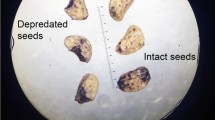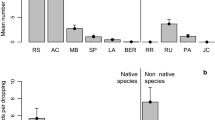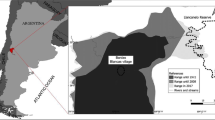Abstract
The success of many alien plant species depends on mutualistic relationships with other species. We describe the assemblage of seed dispersers on three species of alien Opuntia invading Mediterranean and Macaronesian habitats, and examine the quality of such plant-animal interactions. We identified vertebrates consuming O. maxima, O. dillenii and O. stricta fruits by direct observation and collecting droppings and pellets. Phenology of the alien species, as well as that of coexisting native species, was monitored for an entire year. Germination tests of ingested and non-ingested seeds were performed both in the greenhouse and in the field. Seed coat thickness and viability were also measured for all treatments. A great variety of taxa, including reptiles, birds and mammals actively participate in the seed dispersal of Opuntia. Phenology of Opuntia fruits in Menorca and Tenerife overlaps with only a few native fleshy-fruited plants present in the study areas, which suggests an advantage for the invader. Most seeds germinated during the second year of the experiment, independently of the effect produced by the dispersers’ guts. We found great variation in the germination percentage of Opuntia after gut passage and in the effects of ingestion on seed coat thickness. Seed viability was somewhat reduced after gut passage compared to manually depulped seeds. Our results show how different Opuntia species are integrated into native communities by means of mutualistic interactions, with both native and alien dispersers. Although with heterogeneous effects, either type of disperser potentially contributes to the spread of these alien cacti in the recipient areas.



Similar content being viewed by others
References
Arteaga MA, Delgado JD, Otto R, Fernández-Palacios JM, Arévalo JR (2009) How do alien plants distribute along roads on oceanic islands? A case study in Tenerife, Canary Islands. Biol Invas 11:1071–1086
Barbera G, Carimi F, Inglese P (1992) Past and present role of the indian-fig prickly-pear (Opuntia ficus-indica (L) Miller, Cactaceae) in the agriculture of Sicily. Econ Bot 46:10–20
Barquín E, Nogales M, Wildpret W (1986) Intervención de vertebrados en la diseminación de plantas vasculares en Inagua, Gran Canaria (Islas Canarias). Vieraea 16:263–272
Baskin JM, Baskin CC (1977) Seed and seedling ecology of Opuntia compressa in Tennessee Cedar Glades. J Tenn Acad Sci 52:118–122
Bourgeois K, Suehs CM, Vidal E, Médail F (2005) Invasional meltdown potential: facilitation between introduced plants and mammals on French Mediterranean islands. Ecoscience 12:248–256
Bravo-Hollis H (1978) Las Cactáceas de México, vol I. Universidad Nacional Autonóma de México, DF, México
Cordeiro NJ, Patrick DAG, Munisi B, Gupta V (2004) Role of dispersal in the invasion of an exotic tree in an East African submontane forest. J Trop Ecol 20:449–457
Dean WRJ, Milton SJ (2000) Directed dispersal of Opuntia species in the Karoo, South Africa: are crows the responsible agents? J Arid Environ 45:305–314
Elton CS (1958) The ecology of invasions by plants and animals. Methuen, London
Essl F, Kobler J (2008) Spiny invaders—patterns and determinants of cacti invasion in Europe. Flora 204:485–494
Fraga P, Mascaró C, Carreras D, García O, Pellicer X, Pons M, Seoane M, Truyol M (2004) Catàleg de la flora vascular de Menorca. Institut Menorquí d’Estudis, Col·lecció Recerca 9, 368 pp
García de Cortázar V, Nobel PS (1990) Worldwide environmental productivity indices and yield predictors for a CAM plant, Opuntia ficus-indica, including effects of doubled CO2 levels. Agr Forest Meteorol 49:261–279
Gimeno I, Vilà M (2002) Recruitment of two Opuntia species invading abandoned olive groves. Acta Oecol 23:239–246
Gimeno I, Vilà M, Hulme PE (2006) Are islands more susceptible to plant invasion than continents? A test using Oxalis pes-caprae L. in the western Mediterranean. J Biogeogr 33:1559–1565
Grant BR, Grant PR (1981) Exploitation of Opuntia cactus by birds on the Galápagos. Oecologia 49:179–187
Gritti ES, Smith B, Sykes MT (2006) Vulnerability of Mediterranean Basin ecosystems to climate change and invasion by exotic plant species. J Biogeogr 33:145–157
Harris CM, Park KJ, Atkinson R, Edwards C, Travis JMJ (2009) Invasive species control: incorporating demographic data and seed dispersal into a management model for Rhododendron ponticum. Ecol Inform 4:226–233
Hoffmann JH, Moran VC, Zeller DA (1998) Long-term population studies and the development of an integrated management programme for control of Opuntia stricta in Kruger National Park, South Africa. J Appl Ecol 35:156–160
Hulme PE (2004) Islands, invasions and impacts: a Mediterranean perspective. In: Fernández-Palacios JM, Morici M (eds) Ecología insular/island ecology, Asociación Española de Ecología Terrestre (AEET), Cabildo Insular de la Palma, pp 359–383
Hulme PE, Brundu C, Camarda I, Dalias P, Lambdon P, Lloret F, Medail F, Moragues E, Suehs C, Traveset A, Troumbis A, Vilà M (2008) Assessing the risks to Mediterranean islands ecosystems from non-native plant introductions. In: Tokarska-Guzik B, Brock JH, Brundu G, Child L, Daehler CC, Pyšek P (eds) Plant invasions: human perception, ecological impacts and management. Backhuys, Leiden, pp 39–56
Izhaki I, Safriel UN (1990) The effect of some Mediterranean scrubland frugivores upon germination patterns. J Ecol 78:56–65
Janzen DH (1986) Chihuahuan Desert nopaleras: defaunated big mammal vegetation. Annu Rev Ecol Syst 17:595–636
Keane RM, Crawley MJ (2002) Exotic plant invasions and the enemy escape release hypothesis. Trends Ecol Evol 17:164–170
Lambdon PW, Hulme PE (2006) Predicting the invasion success of Mediterranean alien plants from their introduction characteristics. Ecography 29:853–865
Lloret F, Médail F, Brundu G, Hulme PE (2004) Local and regional abundance of exotic plant species on Mediterranean islands: are species traits important? Global Ecol Biogeogr 13:37–45
Lloret F, Médail F, Brundu G, Camarda I, Moragues E, Rita J, Lambdon P, Hulme PE (2005) Species attributes and invasion success by alien plants in Mediterranean islands. J Ecol 93:512–520
López-Darias M, Nogales M (2008) Effects of the invasive Barbary ground squirrel (Atlantoxerus getulus) on seed dispersal systems of insular xeric environments. J Arid Environ 72:926–939
Mandujano MC, Golubov J, Montaña C (1997) Dormancy and endozoochorous dispersal of Opuntia rastrera in the southern Chihuahuan Desert. J Arid Environ 36:259–266
Mandujano MC, Montaña C, Méndez I, Golubov J (1998) The relative contributions of sexual and clonal propagation in Opuntia rastrera from two habitats in the Chihuahuan desert. J Ecol 86:911–921
Marrero P, Padilla DP, Valdés F, Nogales M (2007) Comparison of three chemical tests to assess seed viability: the seeds dispersal system of the Macaronesian endemic plant Rubia fruticosa (Rubiaceae) as an example. Chemoecology 17:47–50
Miller AG, Cope TA (1996) Family 40. Cactaceae. In: Flora of the Arabian Peninsula and Socotra, vol 1. Edinburgh University Press, Edinburgh, pp 305–306
Mitchell CE, Agrawal AA, Bever JD, Gilbert GS, Hufbauer RA, Klironomos JN, Maron JL, Morris WF, Parker IM, Power AG, Seabloom EW, Torchin ME, Vázquez DP (2006) Biotic interactions and plant invasions. Ecol Lett 9:726–740
Montiel S, Montaña C (2000) Vertebrate frugivory and seed dispersal of a Chihuahuan desert cactus. Plant Ecol 146:221–229
Nobel PS (1988) Environmental biology of Agaves and Cacti. Cambridge University Press, Cambridge
Nogales M, Hernández EC, Valdés F (1999) Seed dispersal by Common Ravens Corvus corax among island habitats (Canarian Archipelago). Ecoscience 6:56–61
Nogales M, Medina FM, Quilis V, González-Rodríguez M (2001) Ecological and biogeographical implications of Yellow-Legged Gulls (Larus cachinnans Pallas) as seed dispersers of Rubia fruticosa Ait. (Rubiaceae) in the Canary Islands. J Biogeogr 28:1137–1145
Nogales M, Nieves C, Illera JC, Padilla DP, Traveset A (2005) Effect of native and alien vertebrate frugivores on seed viability and germination patterns of Rubia fruticosa (Rubiaceae) in the eastern Canary Islands. Funct Ecol 19:429–436
Nogales M, Nieves C, Padilla DP, Illera JC (2006) Native dispersers induce germination asynchrony in a macaronesian endemic plant (Rubia fruticosa, Rubiaceae) in xeric environments of the Canary Islands. J Arid Environ 64:357–363
Olesen J, Valido A (2003) Lizards as pollinators and seed dispersers: an island phenomenon. Trends Ecol Evol 18:177–181
Ööpik M, Kukk T, Kull K, Kull T (2008) The importance of human mediation in species establishment: analysis of the alien flora of Estonia. Boreal Environ Res 13:53–67
Racine CH, Downhower JF (1974) Vegetative and reproductive strategies of Opuntia (Cactaceae) in The Galapagos Islands. Biotropica 6:175–186
Reinhardt CF, Rossouw L (2000) Ecological adaptation of an alien invader plant (Opuntia stricta) determines management strategies in the Kruger National Park. J Plant Dis Protect 17:77–84
Renne IJ, Wylie C, Barrow WC, Johnson Randall LA, Bridges WC (2002) Generalized avian dispersal syndrome contributes to Chinese tallow tree (Sapium sebiferum, Euphorbiaceae) invasiveness. Divers Distrib 8:285–295
Reyes-Agüero JA, Aguirre JR, Valiente-Banuet A (2006) Reproductive biology of Opuntia: a review. J Arid Environ 64:549–585
Richardson DM, Allsopp N, D’Antonio CM, Milton SJ, Rejmánek M (2000) Plant invasions—the role of mutualisms. Biol Rev 75:65–93
Sala OE, Chapin FS, Armesto JJ, Berlow E, Bloomfield J, Dirzo R, Huber-Sanwald E, Huenneke LF, Jackson RB, Kinzig A, Leemans R, Lodge DM, Mooney HA, Oesterheld M, Poff NL, Sykes MT, Walker BH, Walker M, Wall DH (2000) Global biodiversity scenarios for the year 2100. Science 287:1770–1774
Sax DF, Gaines SD (2008) Species invasions and extinction: the future of native biodiversity on islands. Proc Natl Acad Sci USA 105:11490–11497
Sax DF, Stachowicz JJ, Brown JH, Bruno JF, Dawson MN, Gaines SD, Grosberg RK, Hastings A, Holt RD, Mayfield MM, O’Connor MI, Rice WR (2007) Ecological and evolutionary insights from species invasions. Trends Ecol Evol 22:465–471
Scharpf RF (1970) Seed viability, germination and radicle growth of Dwarf Mistletoe in California. Research paper PSW-59. USDA Forest Service of California, USA
Simberloff D, Von Holle B (1999) Positive interactions of nonindigenous species: invasional meltdown? Biol Invasions 1:21–32
Timmons FL (1941) The dissemination of prickly pear seed by jackrabbits. J Am Soc Agron 34:513–520
Traveset A (1998) Effect of seed passage through vertebrate frugivores’ guts on germination: a review. Perspect Plant Ecol Evol Syst 1/2:151–190
Traveset A, Richardson D (2006) Biological invasions as disruptors of plant reproductive mutualisms. Trends Ecol Evol 21:208–216
Traveset A, Verdú M (2002) A meta-analysis of the effect of gut treatment on seed germination. In: Levey DJ, Silva WR, Galetti M (eds) Seed dispersal and frugivory: ecology, evolution and conservation. CABI, Wallingford, pp 339–350
Traveset A, Riera N, Mas RE (2001) Passage through bird causes interspecific differences in seed germination characteristics. Funct Ecol 15:669–675
Traveset A, Brundu G, Carta L, Mprezetou I, Lambdon P, Manca M, Médail F, Moragues E, Rodríguez-Pérez J, Siamantziouras ASD, Suehs CM, Troumbis AY, Vilà M, Hulme PE (2008a) Consistent performance of invasive plant species within and among islands of the Mediterranean basin. Biol Invasions 10:847–858
Traveset A, Rodríguez-Pérez J, Pías B (2008b) Seed trait changes in dispersers’ guts and consequences for germination and seedling growth. Ecology 89:95–106
Valido A (1999) Ecología de la dispersión de semillas por los lagartos endémicos canarios (g. Gallotia, Lacertidae). Dissertation, University of La Laguna, Tenerife, Canary Islands, Spain
Valido A, Nogales M (1994) Frugivory and seed dispersal by the lizard Gallotia galloti (Lacertidae) in a xeric habitat of the Canary Islands. Oikos 70:403–411
Valido A, Nogales M (2003) Digestive ecology of two omnivorous Canarian lizard species (Gallotia, Lacertidae). Amphibia-Reptilia 24:331–344
Valido A, Nogales M, Medina FM (2003) Fleshy fruits in the diet of Canarian lizards Gallotia galloti (Lacertidae) in a xeric habitat of the island of Tenerife. J Herpetol 37:741–747
Vargas MMC, González EM (1992) Habitat heterogeneity and seed dispersal of Opuntia streptacantha in nopaleras of central Mexico. Southwest Nat 37:379–385
Verdú M, Traveset A (2005) Early emergence enhances plant fitness: a phylogenetically controlled meta-analysis. Ecology 86:1385–1394
Vilà M, Gimeno I (2001) Patterns of invasion of Opuntia sp. pl. abandoned olive groves in Catalonia (Spain). In: Brundu G, Brock J, Camarda I, Child L, Wade M (eds) Plant invasions: species ecology and ecosystem management. Backhuys Publishers, Leiden, pp 169–174
Vilà M, Gimeno I (2003) Seed predation of two alien Opuntia species invading Mediterranean communities. Plant Ecol 167:1–8
Vilà M, Gimeno I (2006) Potential for higher invasiveness of the alien Oxalis pes-caprae on islands than on the mainland. Plant Ecol 183:47–53
Vilà M, Burriel JA, Pino J, Chamizo J, Llach E, Porterias M, Vives M (2003) Association between Opuntia species invasion and changes in land-cover in the Mediterranean region. Glob Change Biol 9:1234–1239
Vilà M, Siamantziouras ASD, Brundu G, Camarda I, Lambdon P, Médail F, Moragues E, Suehs CM, Traveset A, Troumbis AY, Hulme PE (2008) Widespread resistance of Mediterranean island ecosystems to the establishment of three alien species. Divers Distrib 14:839–851
Walter TR, Schmincke HU (2002) Rifting, recurrent landsliding and Miocene structural reorganization on NW-Tenerife (Canary Islands). Int J Earth Sci 91:615–628
Acknowledgments
We thank R. Gutiérrez, A. González-Castro, A. Rodríguez, C. Nieves, D. Domínguez and E. Descals for their help in the field and germination tests. We are especially grateful to the staff of the S’Albufera des Grau Natural Park (Menorca), Teno Natural Park (Tenerife), Serra Gelada e islotes Natural Park and the staff of the wildlife rehabilitation centre “La Granja” for their continuous logistic support. O. García was particularly helpful at providing the contacts to work in the study sites in Menorca. S. Pons, A. Bertolero and V. Pérez-Mellado kindly help us with droppings’ identification. M. Fuster helped with the map in the Fig. 1. We also thank D. Simberloff and one anonymous reviewer for valuable comments provided on a previous version of this manuscript. Research was funded by the Spanish Ministry of Science and Education and FEDER funds of the European Union (CGL2004-0161BOS and CGL2007-61165BOS projects). Some authors have been funded by several Spanish grants (BP: Spanish Ministry of Science and Education, AMA: JAE-doc CSIC, DPP: Canarian Government and PM: Proyectos Intramurales CSIC).
Author information
Authors and Affiliations
Corresponding author
Rights and permissions
About this article
Cite this article
Padrón, B., Nogales, M., Traveset, A. et al. Integration of invasive Opuntia spp. by native and alien seed dispersers in the Mediterranean area and the Canary Islands. Biol Invasions 13, 831–844 (2011). https://doi.org/10.1007/s10530-010-9872-y
Received:
Accepted:
Published:
Issue Date:
DOI: https://doi.org/10.1007/s10530-010-9872-y




